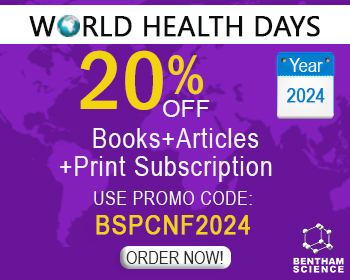Abstract
Natural products are compounds isolated from plants that provide a variety of lead structures for the development of new drugs by the pharmaceutical industry. The interest in these substances increases because of their beneficial effects on human health. Alzheimer's disease (AD) affects occur in about 80% of individuals aged 65 years. AD, the most common cause of dementia in elderly people, is characterized by progressive neurodegenerative alterations, as decrease of cholinergic impulse, increased toxic effects caused by reactive oxygen species and the inflammatory process that the amyloid plaque participates. In silico studies is relevant in the process of drug discovery; through technological advances in the areas of structural characterization of molecules, computational science and molecular biology have contributed to the planning of new drugs used against neurodegenerative diseases. Considering the social impairment caused by an increased incidence of disease and that there is no chemotherapy treatment effective against AD; several compounds are studied. In the researches for effective neuroprotectants as potential treatments for Alzheimer's disease, natural products have been extensively studied in various AD models. This study aims to carry out a literature review with articles that address the in silico studies of natural products aimed at potential drugs against Alzheimer's disease (AD) in the period from 2015 to 2021.
Keywords: Alzheimer’s disease, amyloid plaque, cholinergic impulse, in silico studies, natural products, oxigen-reactive species (ROS).
[http://dx.doi.org/10.1007/978-981-10-8417-1_9]
[http://dx.doi.org/10.1016/j.fitote.2011.08.007] [PMID: 21867747]
[http://dx.doi.org/10.1093/ecam/nem167] [PMID: 18955290]
[http://dx.doi.org/10.12688/f1000research.6653.1] [PMID: 26949519]
[http://dx.doi.org/10.1016/j.str.2005.01.009] [PMID: 15766549]
[http://dx.doi.org/10.3390/molecules24132358] [PMID: 31247973]
[http://dx.doi.org/10.1111/cbdd.12011] [PMID: 22863071]
[PMID: 11560063]
[http://dx.doi.org/10.1021/ci700286x] [PMID: 18034468]
[http://dx.doi.org/10.1016/j.jsps.2018.02.015] [PMID: 29991919]
[http://dx.doi.org/10.7213/rpa.v26i54.19649]
[http://dx.doi.org/10.1016/j.bbrc.2011.11.123] [PMID: 22166205]
[http://dx.doi.org/10.2165/11586390-000000000-00000] [PMID: 21174483]
[http://dx.doi.org/10.1016/j.pneurobio.2012.03.005] [PMID: 22459297]
[http://dx.doi.org/10.1002/alz.12328] [PMID: 33756057]
[http://dx.doi.org/10.1038/nrneurol.2011.2] [PMID: 21304480]
[http://dx.doi.org/10.1016/j.bbadis.2011.10.006] [PMID: 22019723]
[http://dx.doi.org/10.1016/j.ejmech.2018.02.035] [PMID: 29477076]
[http://dx.doi.org/10.1016/j.bbr.2014.12.006] [PMID: 25496781]
[http://dx.doi.org/10.1016/j.jphs.2014.12.015] [PMID: 25727952]
[http://dx.doi.org/10.1016/j.pharep.2014.09.004] [PMID: 25712639]
[http://dx.doi.org/10.1016/j.pharep.2015.07.006] [PMID: 26721364]
[http://dx.doi.org/10.1002/med.21434] [PMID: 28084618]
[http://dx.doi.org/10.2174/1381612822666151125000550] [PMID: 26601966]
[http://dx.doi.org/10.1021/jm4004285] [PMID: 24351051]
[http://dx.doi.org/10.4018/978-1-5225-0549-5.ch003]
[http://dx.doi.org/10.3390/molecules200713384] [PMID: 26205061]
[http://dx.doi.org/10.1111/cbdd.12503] [PMID: 25546316]
[http://dx.doi.org/10.1016/j.ijbiomac.2014.08.052] [PMID: 25199867]
[http://dx.doi.org/10.1007/s00432-014-1805-1] [PMID: 25143306]
[http://dx.doi.org/10.1007/s12272-014-0503-5] [PMID: 25348867]
[http://dx.doi.org/10.3109/13880209.2013.764329] [PMID: 23570516]
[http://dx.doi.org/10.2174/0929867321666141106122628] [PMID: 25386820]
[http://dx.doi.org/10.1016/j.jfda.2016.11.004] [PMID: 28911541]
[http://dx.doi.org/10.5897/JMPR11.1404]
[http://dx.doi.org/10.1002/ptr.6419] [PMID: 31359516]
[http://dx.doi.org/10.1007/s11130-013-0370-0] [PMID: 23881465]
[http://dx.doi.org/10.1001/archneurol.2010.144] [PMID: 20625087]
[http://dx.doi.org/10.18632/aging.100691] [PMID: 25324469]
[http://dx.doi.org/10.1016/j.bbagen.2013.06.031] [PMID: 23830862]
[http://dx.doi.org/10.1007/s12035-014-8722-9] [PMID: 24826916]
[http://dx.doi.org/10.1016/j.neulet.2010.03.062] [PMID: 20356566]
[http://dx.doi.org/10.1021/jf100128b] [PMID: 20302342]
[http://dx.doi.org/10.1016/j.neuropharm.2011.09.016] [PMID: 21958557]
[http://dx.doi.org/10.1080/14786419.2014.986729] [PMID: 25482370]
[http://dx.doi.org/10.1016/j.arabjc.2013.11.017]
[http://dx.doi.org/10.1515/ap-2015-0013] [PMID: 26204026]
[http://dx.doi.org/10.1016/j.bmcl.2014.12.075] [PMID: 25592715]
[http://dx.doi.org/10.1021/jm501285x] [PMID: 25474410]
[http://dx.doi.org/10.1007/s11262-014-1098-0] [PMID: 24986787]
[http://dx.doi.org/10.1016/j.mehy.2014.01.019] [PMID: 24524922]
[http://dx.doi.org/10.3329/bjp.v8i2.13886]
[http://dx.doi.org/10.1111/imm.12416] [PMID: 25346443]
[http://dx.doi.org/10.1523/JNEUROSCI.0969-14.2015] [PMID: 25673832]
[http://dx.doi.org/10.1074/jbc.M114.630699] [PMID: 25572400]
[http://dx.doi.org/10.1016/j.bmcl.2013.07.020] [PMID: 23927974]
[http://dx.doi.org/10.1042/bj2600625] [PMID: 2669736]
[http://dx.doi.org/10.1021/jp053736x] [PMID: 16854005]
[http://dx.doi.org/10.2478/s11696-014-0542-x]
[http://dx.doi.org/10.1002/gps.4163] [PMID: 25092795]
[http://dx.doi.org/10.1186/s12929-014-0084-0] [PMID: 25239202]
[http://dx.doi.org/10.2478/s13380-014-0222-x]
[http://dx.doi.org/10.1016/j.ijbiomac.2016.11.062] [PMID: 27871793]
[http://dx.doi.org/10.1186/s40035-017-0093-5] [PMID: 28855981]
[http://dx.doi.org/10.2174/138920207783769512] [PMID: 19415126]
[http://dx.doi.org/10.1038/aps.2011.14] [PMID: 21499284]
[http://dx.doi.org/10.1021/acs.jnatprod.6b00643] [PMID: 28128562]
[http://dx.doi.org/10.1007/s00044-014-1081-2]
[http://dx.doi.org/10.3390/molecules23102479] [PMID: 30262742]
[http://dx.doi.org/10.1080/13880209.2021.1913189] [PMID: 33930998]
[http://dx.doi.org/10.1016/j.heliyon.2020.e04930] [PMID: 32995619]
[http://dx.doi.org/10.3389/fphar.2017.00083] [PMID: 28289386]
[http://dx.doi.org/10.3390/molecules25184064] [PMID: 32899576]
[http://dx.doi.org/10.1016/j.bioorg.2019.03.034] [PMID: 30927588]
[http://dx.doi.org/10.1016/j.arabjc.2021.103188]
[http://dx.doi.org/10.1351/pac200072081493]
[http://dx.doi.org/10.1155/2020/3098673]
[http://dx.doi.org/10.1016/j.bioorg.2018.11.041] [PMID: 30529844]
[http://dx.doi.org/10.1016/j.fitote.2020.104541] [PMID: 32151639]
[http://dx.doi.org/10.1016/j.cbi.2015.07.008] [PMID: 26297990]
[http://dx.doi.org/10.1016/j.bioorg.2018.02.001] [PMID: 29477125]
[http://dx.doi.org/10.1186/1742-2094-11-118] [PMID: 24985096]
[http://dx.doi.org/10.1002/ajoc.202100039]
[http://dx.doi.org/10.1016/j.ejmech.2014.03.047] [PMID: 24691058]
[http://dx.doi.org/10.1021/cr400265z] [PMID: 24555663]
[http://dx.doi.org/10.3390/molecules26020431] [PMID: 33467544]
[http://dx.doi.org/10.1155/2013/621459]
[http://dx.doi.org/10.15171/bi.2019.11] [PMID: 31334039]
[http://dx.doi.org/10.1016/j.bmcl.2019.126927] [PMID: 31901382]
[http://dx.doi.org/10.1155/2017/8587260]
[http://dx.doi.org/10.1002/cbdv.202000442] [PMID: 32692899]
[http://dx.doi.org/10.1016/j.bmc.2016.07.061] [PMID: 27519464]
[http://dx.doi.org/10.1016/j.bioorg.2018.09.010] [PMID: 30245233]
[http://dx.doi.org/10.1016/j.bmc.2015.01.042] [PMID: 25678013]
[http://dx.doi.org/10.1590/S0100-40422012001100008]
[http://dx.doi.org/10.3390/molecules17044684] [PMID: 22522398]
[http://dx.doi.org/10.1039/C8OB02319K] [PMID: 30427367]
[http://dx.doi.org/10.3390/biom11030350] [PMID: 33669097]
[http://dx.doi.org/10.5487/TR.2017.33.2.097] [PMID: 28443180]
[http://dx.doi.org/10.1186/1471-2164-15-676] [PMID: 25112168]
[http://dx.doi.org/10.3390/molecules19044466] [PMID: 24727418]
[http://dx.doi.org/10.1016/j.ejmech.2012.12.014] [PMID: 23354070]
[http://dx.doi.org/10.1016/j.bmcl.2015.03.046] [PMID: 25845281]
[http://dx.doi.org/10.1016/j.bmc.2014.12.026] [PMID: 25662701]
[http://dx.doi.org/10.1371/journal.pone.0107950] [PMID: 25237809]
[http://dx.doi.org/10.1016/j.jhep.2014.11.040] [PMID: 25500144]
[http://dx.doi.org/10.1016/j.bioorg.2019.102947] [PMID: 31028989]
[http://dx.doi.org/10.1016/j.bioorg.2018.01.009] [PMID: 29421695]
[http://dx.doi.org/10.1016/j.bmc.2019.115251] [PMID: 31848115]
[http://dx.doi.org/10.1080/07391102.2019.1633408] [PMID: 31204906]
[http://dx.doi.org/10.15171/bi.2020.03] [PMID: 31988853]
[http://dx.doi.org/10.3390/ijms21062071] [PMID: 32197305]
[http://dx.doi.org/10.1080/08927022.2017.1334880]
[http://dx.doi.org/10.1016/j.apjtm.2017.10.018] [PMID: 29268966]
[http://dx.doi.org/10.1002/ardp.201900177] [PMID: 31478569]
[http://dx.doi.org/10.1016/j.neuropharm.2013.07.004] [PMID: 23891641]
[http://dx.doi.org/10.1111/joim.12191] [PMID: 24605808]
[http://dx.doi.org/10.3390/molecules24071340] [PMID: 30959739]
[http://dx.doi.org/10.1016/j.ejmech.2015.08.039] [PMID: 26415837]
[http://dx.doi.org/10.4155/fmc.11.67] [PMID: 21707398]
[http://dx.doi.org/10.1002/pca.2736] [PMID: 29044771]
[http://dx.doi.org/10.3390/molecules171113473] [PMID: 23149565]
[http://dx.doi.org/10.1016/j.indcrop.2012.07.034]
[http://dx.doi.org/10.1007/s11064-017-2295-8] [PMID: 28497342]
[http://dx.doi.org/10.1111/jphp.12081] [PMID: 24236980]
[http://dx.doi.org/10.3389/fnins.2021.617821] [PMID: 33679301]
[http://dx.doi.org/10.1016/j.bioorg.2020.104567] [PMID: 33387730]
[http://dx.doi.org/10.1007/s10822-020-00372-4] [PMID: 33439402]
[http://dx.doi.org/10.1016/j.bioorg.2020.103928] [PMID: 32450384]
[http://dx.doi.org/10.3390/biom10050800] [PMID: 32455879]
[http://dx.doi.org/10.3390/molecules25092092] [PMID: 32365796]
[http://dx.doi.org/10.3390/molecules25071609] [PMID: 32244635]
[http://dx.doi.org/10.1080/14786419.2020.1727471] [PMID: 32067490]



























